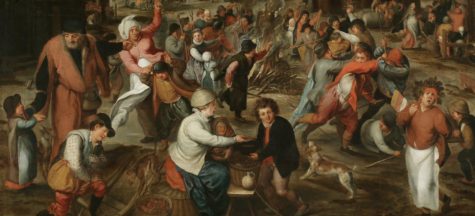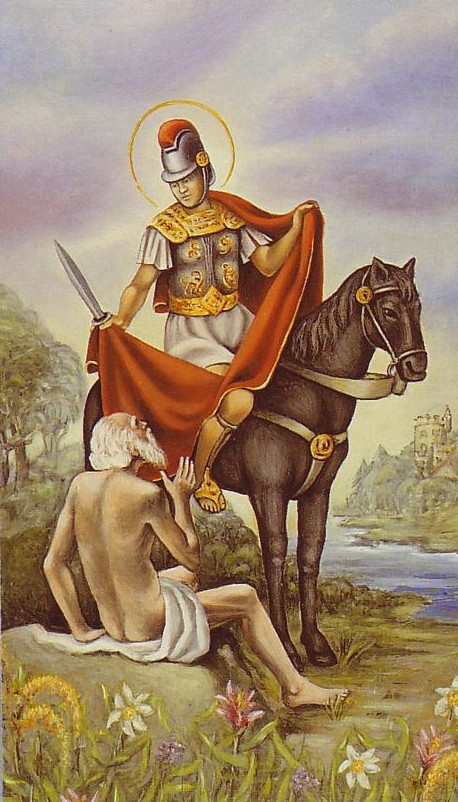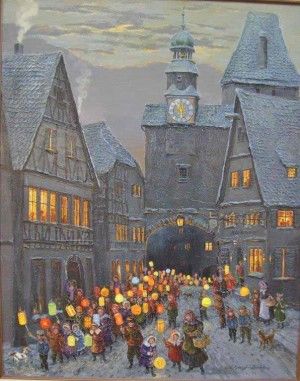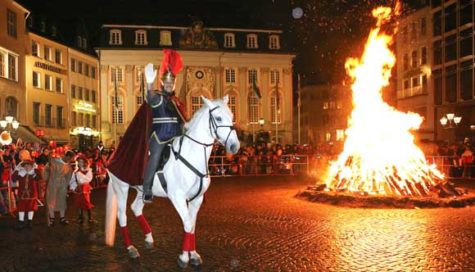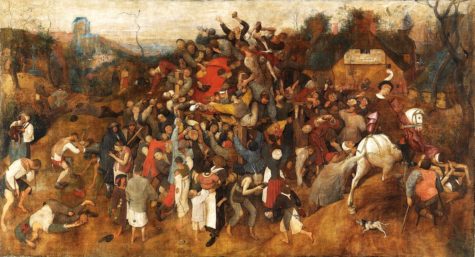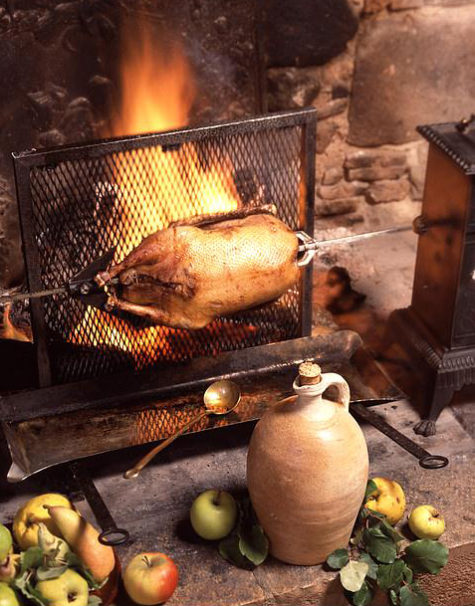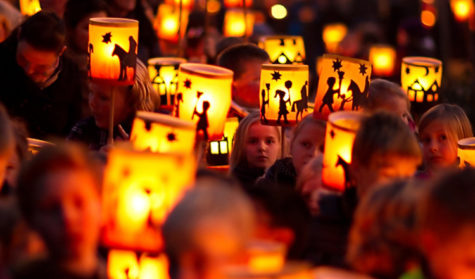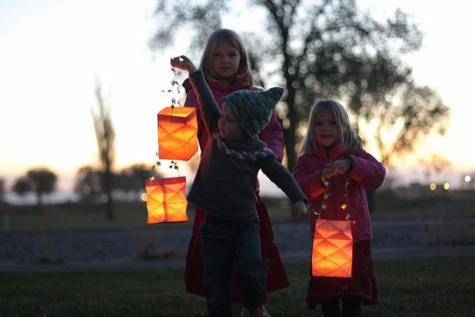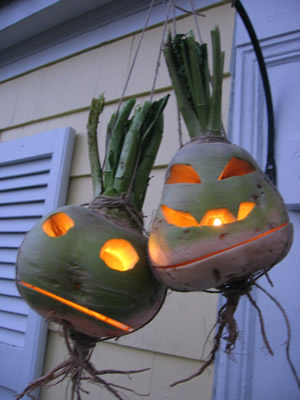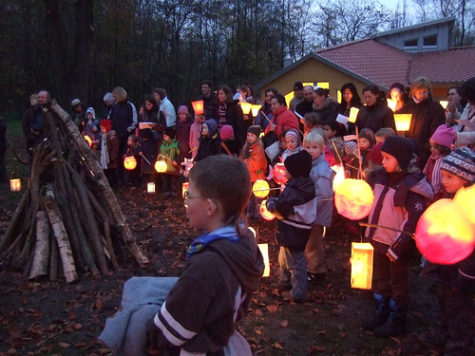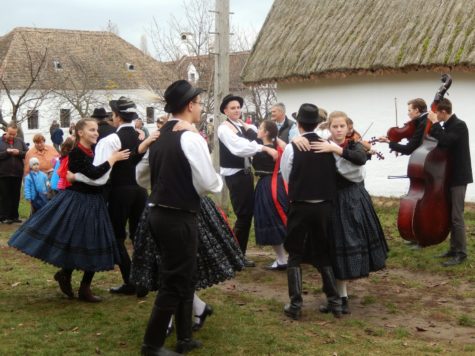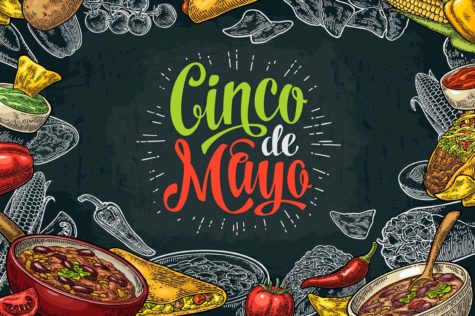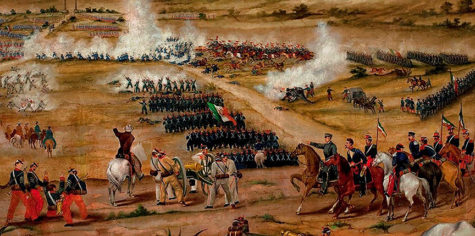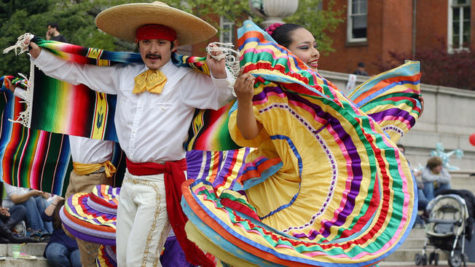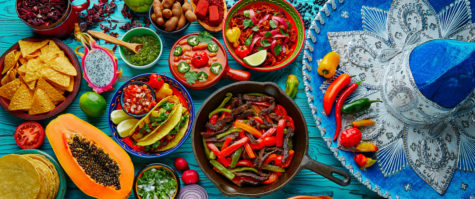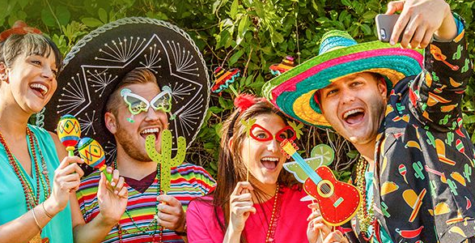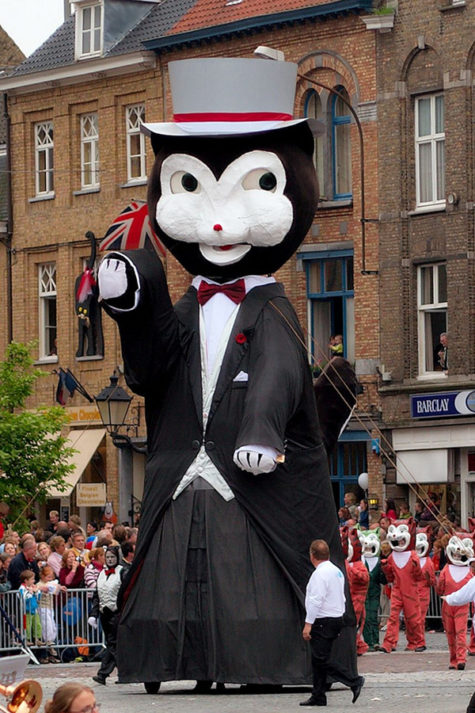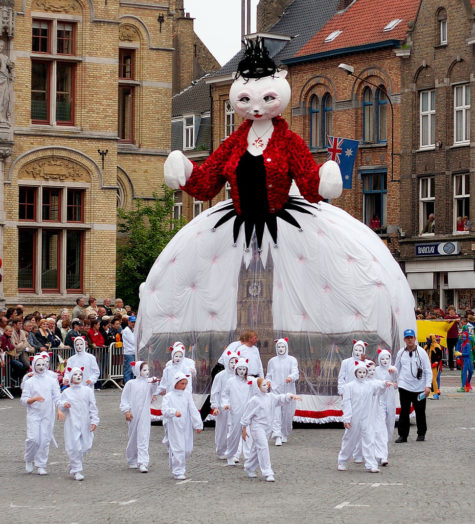Parades
Saint Martin’s Day, also known as the Feast of Saint Martin, Martinstag or Martinmas, as well as Old Halloween and Old Hallowmas Eve, is the feast day of Saint Martin of Tours (Martin le Miséricordieux) and is celebrated on November 11 each year. This is the time when autumn wheat seeding was completed, and the annual slaughter of fattened cattle produced “Martinmas beef”. Historically, hiring fairs were held where farm laborers would seek new posts.
Saint Martin of Tours started out as a Roman soldier then was baptized as an adult and became a monk. It is understood that he was a kind man who led a quiet and simple life. The best known legend of his life is that he once cut his cloak in half to share with a beggar during a snowstorm, to save the beggar from dying from the cold. That night he dreamed that Jesus was wearing the half-cloak. Martin heard Jesus say to the angels, “Here is Martin, the Roman soldier who is now baptized; he has clothed me.”
St. Martin was known as friend of the children and patron of the poor. This holiday originated in France, then spread to the Low Countries, the British Isles, Germany, Scandinavia, and Eastern Europe. It celebrates the end of the agrarian year and the end of the harvest.
Bishop Perpetuus of Tours, who died in 490, ordered fasting three days a week from the day after Saint Martin’s Day (11 November). In the 6th century, local councils required fasting on all days except Saturdays and Sundays from Saint Martin’s Day to Epiphany (the Feast of the Three Wise Men and the star, c.f. Matthew 2: 1-12) on January 6, a period of 56 days, but of 40 days fasting, like the fast of Lent. It was therefore called Quadragesima Sancti Martini (Saint Martin’s Lent). This period of fasting was later shortened and called “Advent” by the Church.
The goose became a symbol of St. Martin of Tours because of a legend that when trying to avoid being ordained bishop he had hidden in a goose pen, where he was betrayed by the cackling of the geese. St. Martin’s feast day falls in November, when geese are ready for killing.
St. Martin’s Day was an important medieval autumn feast, and the custom of eating goose spread to Sweden from France. It was primarily observed by the craftsmen and noblemen of the towns. In the peasant community, not everyone could afford to eat goose, so many ate duck or hen instead.
Martinmas
Martinmas literally means “Mass of Martin”, or the day when Catholics celebrate the Holy Catholic Mass which honors St. Martin in a special way.
Martinmas, as a date on the calendar, has two meanings: in the agricultural calendar it marks the beginning of the natural winter, but in the economic calendar it is seen as the end of autumn. The feast coincides not only with the end of the Octave of All Saints, but with harvest-time, the time when newly produced wine is ready for drinking, and the end of winter preparations, including the butchering of animals.
An old English saying is “His Martinmas will come as it does to every hog,” meaning “he will get his comeuppance” or “everyone must die”. Because of this, St. Martin’s Feast is much like the American Thanksgiving – a celebration of the earth’s bounty. Because it also comes before the penitential season of Advent, it is seen as a mini “carnivale”, with all the feasting and bonfires.
As at Michaelmas on 29 September, goose is eaten in most places. Following these holidays, women traditionally moved their work indoors for the winter, while men would proceed to work in the forests.
In some countries, Martinmas celebrations begin at the eleventh minute of the eleventh hour of this eleventh day of the eleventh month (that is, at 11:11 am on November 11). In others, the festivities commence on St. Martin’s Eve (that is, on November 10). Bonfires are built and children carry lanterns in the streets after dark, singing songs for which they are rewarded with candy.
It is also a day of wine tasting and drinking.
Celebrations around the world:
- Austria
“Martinloben” is celebrated as a collective festival. Events include art exhibitions, wine tastings, and live music. “Martinigansl” (roasted goose) is the traditional dish of the season. In Austria St. Martin’s Day is celebrated the same way as in Germany.The nights before and on the night of Nov. 11, children walk in processions carrying lanterns, which they made in school, and sing Martin songs.
- Belgium
The day is celebrated on the evening of November 11 in a small part of Belgium (mainly in the east of Flanders and around Ypres). Children go through the streets with paper lanterns and candles, and sing songs about St. Martin. Sometimes, a man dressed as St. Martin rides on a horse in front of the procession.
In some areas, there is a traditional goose meal, although in West Flanders there is no specific meal; in other areas it is more a day for children, with toys brought on the night of 10 to 11 November. In the east part of the Belgian province of West Flanders, especially around Ypres, children receive presents from either their friends or family as supposedly coming from St. Martin on November 11. In other areas it is customary that children receive gifts later in the year from either their friends or family as supposedly coming from Saint Nicholas on December 5 or 6 (called Sinterklaas in Belgium and the Netherlands) or Santa Claus on December 25.
In other areas, children go from door to door, singing traditional “Sinntemette” songs, sporting a hollow beetroot with a carved face and a candle inside. Later in the evening there is a bonfire where all of them gather. At the end the beetroots are thrown into the fire, and pancakes are being served.
- Croatia, Slovenia
In Croatia, St. Martin’s Day (Martinje, Martinovanje) marks the day when the must traditionally turns to wine. The must is usually considered impure and sinful, until it is baptized and turned into wine. The baptism is performed by someone who dresses up as a bishop and blesses the wine; this is usually done by the host. Another person is chosen as the godfather of the wine. The foods traditionally eaten on the day are goose and home-made or store bought mlinci.
The biggest event in Slovenia is the St. Martin’s Day celebration in Maribor which marks the symbolic winding up of all the wine growers’ endeavours. There is the ceremonial “christening” of the new wine, and the arrival of the Wine Queen. The square Trg Leona Štuklja is filled with musicians and stalls offering autumn produce and delicacies.
- Slovakia
In Slovakia, the Feast of St. Martin is like a “2nd Birthday” for those named after this saint. Small presents or money are common gifts for this special occasion. Tradition says that if it snows on the feast of St. Martin, November 11, then St. Martin came on a white horse and there will be snow on Christmas day. However, if it doesn’t snow on this day, then St. Martin came on a dark horse and it will not snow on Christmas.
- Czech Republic
A Czech proverb connected with the Feast of St. Martin – Martin přijíždí na bílém koni (trans. “Martin is coming on a white horse”) – signifies that the first half of November in the Czech Republic is the time when it often starts to snow. St. Martin’s Day is the traditional feast day in the run-up to Advent.
Roasted goose is usually found on restaurant menus, and the Czech version of Beaujolais nouveau, Svatomartinské víno, a young wine from the recent harvest, which has recently become more widely available and popular. Wine shops and restaurants around Prague pour the first of the St. Martin’s wines at 11:11 a.m. Many restaurants offer special menus for the day, featuring the traditional roast goose.
- Denmark
In Denmark, Mortensaften, meaning the evening of St. Martin, is celebrated with traditional dinners, while the day itself is rarely recognized. (Morten is the Danish vernacular form of Martin.) The background is the same legend as mentioned above, but nowadays the goose is most often replaced with a duck due to size, taste and/or cost.
- Estonia
In Estonia, Martinmas signifies the merging of Western European customs with local Balto-Finnic pagan traditions. It also contains elements of earlier worship of the dead as well as a certain year-end celebration that predates Christianity. For centuries mardipäev (Martinmas) has been one of the most important and cherished days in the Estonian folk calendar. It remains popular today, especially among young people and the rural population. Martinmas celebrates the end of the agrarian year and the beginning of the winter period.
Among Estonians, Martinmas also marks the end of the period of All Souls, as well as the autumn period in the Estonian popular calendar when the souls of ancestors were worshiped, a period that lasted from November 1 to Martinmas (November 11). On this day children disguise themselves as men and go from door to door, singing songs and telling jokes to receive sweets.
In Southern Estonia, November is called Märtekuu after St. Martin’s Day.
- Germany
A widespread custom in Germany is bonfires on St. Martin’s eve, called “Martinsfeuer.” In recent years, the processions that accompany those fires have been spread over almost a fortnight before Martinmas. At one time, the Rhine River valley would be lined with fires on the eve of Martinmas. In the Rhineland region, Martin’s day is celebrated traditionally with a get-together during which a roasted suckling pig is shared with the neighbors.
The nights before and on the night of Nov. 11, children walk in processions carrying lanterns, which they made in school, and sing Martin songs. Usually, the walk starts at a church and goes to a public square. A man on horseback dressed like St. Martin accompanies the children. When they reach the square, Martin’s bonfire is lit and Martin’s pretzels are distributed.
In some regions of Germany (e.g. Rhineland or Bergisches Land) in a separate procession the children also go from house to house with their lanterns, sing songs and get candy in return.
The origin of the procession of lanterns is unclear. To some, it is a substitute for the St. Martin bonfire, which is still lit in a few cities and villages throughout Europe. It formerly symbolized the light that holiness brings to the darkness, just as St. Martin brought hope to the poor through his good deeds. Even though the tradition of the large, crackling fire is gradually being lost, the procession of lanterns is still practiced.
The tradition of the St. Martin’s goose or “Martinsgans”, which is typically served on the evening of St. Martin’s feast day following the procession of lanterns, most likely evolved from the well-known legend of St. Martin and the geese. “Martinsgans” is usually served in restaurants, roasted, with red cabbage and dumplings.
In some regions of Germany, the traditional sweet of Martinmas is “Martinshörnchen”, a pastry shaped in the form of a croissant, which recalls both the hooves of St. Martin’s horse and, by being the half of a pretzel, the parting of his mantle. In parts of western Germany these pastries are instead shaped like men (Stutenkerl or Weckmänner).
- Great Britain
In the United Kingdom, St. Martin’s Day is known as Martinmas (or sometimes Martlemass). It is one of the term days in Scotland. Many schools celebrate St. Martin’s day. Many schools are also named after St. Martin.
Martlemass beef was from cattle slaughtered at Martinmas and salted or otherwise preserved for the winter. The now largely archaic term “St. Martin’s Summer” referred to the fact that in Britain people often believed there was a brief warm spell common around the time of St. Martin’s Day, before the winter months began in earnest. A similar term that originated in America is “Indian Summer”.
- Ireland
In Ireland, on the eve of St. Martin’s Day, it is tradition to sacrifice a cockerel by bleeding it. The blood was collected and sprinkled on the four corners of the house. Also in Ireland, no wheel of any kind was to turn on St. Martin’s Day, because Martin was thrown into a mill stream and killed by the wheel and so it was not right to turn any kind of wheel on that day.
- Sicily
In Sicily, November is the winemaking season. On St. Martin’s Day Sicilians eat anise biscuits washed down with Moscato, Malvasia or Passito. More precisely, the hard biscuits are dipped into the Moscato. l’Estate di San Martino (Saint Martin’s Summer) is the traditional Sicilian reference to a period of unseasonably warm weather in early to mid November. Saint Martin’s Day is celebrated in a special way in a village near Messina and at a monastery dedicated to him overlooking Palermo beyond Monreale.
- Latvia
Mārtiņi (Martin’s) is traditionally celebrated by Latvians on November 10, marking the end of the preparations for winter, such as salting meat and fish, storing the harvest and making preserves. Mārtiņi also marks the beginning of masquerading and sledding, among other winter activities.
- Malta
St. Martin’s Day (Jum San Martin in Maltese) is celebrated in Malta on the Sunday nearest to November 11. Children are given a bag full of fruits and sweets associated with the feast, known by the Maltese as Il-Borża ta’ San Martin, “St. Martin’s bag”.
This bag may include walnuts, hazelnuts, almonds, chestnuts, dried or processed figs, seasonal fruit (like oranges, tangerines, apples and pomegranates) and “Saint Martin’s bread roll” (Maltese: Ħobża ta’ San Martin). In old days, nuts were used by the children in their games.
There is a traditional rhyme associated with this custom:
Ġewż, Lewż, Qastan, Tin
Kemm inħobbu lil San Martin.
Walnuts, Almonds, Chestnuts, Figs
I love Saint Martin so much.
A feast is celebrated in the village of Baħrija on the outskirts of Rabat (Malta), including a procession led by the statue of Saint Martin. There is also a fair, and a show for local animals. San Anton School, a private school on the island, organises a walk to and from a cave especially associated with Martin in remembrance of the day.
- Netherlands
The day is celebrated on the evening of the 11th of November (the day Saint Martin died), where he is known as Sint-Maarten. As soon it gets dark, children up to the age of 11 or 12 (primary school age) go door to door with hand-crafted lanterns made of hollowed-out sugar beet or, more recently, paper, singing songs such as “Sinte Sinte Maarten,” hoping to receive candy in return, similar to Halloween.
In the past, poor people would visit farms on the 11th of November, to get food for the winter. In the 1600’s, the city of Amsterdam held boat races. 400 to 500 light craft, both rowing boats and sailboats, took part under the eyes of a vast crowd on the banks.
- Poland
St. Martin’s Day is celebrated mainly in the city of Poznań. On November 11, the people of Poznań buy and eat considerable amounts of “Rogale” (pronounced Ro-gah-leh), locally produced croissants, made specially for this occasion, filled with almond paste with poppy seeds, so-called “Rogal świętomarciński” or Martin Croissants or St. Martin Croissants.
Legend has it this centuries-old tradition commemorates a Poznań baker’s dream. His nighttime reveries had St. Martin entering the city on a white horse that lost its golden horseshoe. The very next morning, the baker whipped up horseshoe-shaped croissants filled with almonds, white poppy seeds and nuts, and gave them to the poor.
In recent years, competition amongst local bakeries has become fierce for producing the best “Rogale,” and very often bakeries proudly display a certificate of compliance with authentic, traditional recipes. Poznanians celebrate with a feast, specially organised by the city. There are different concerts, a St. Martin’s parade and a fireworks show.
- Portugal
In Portugal, St. Martin’s Day is commonly associated with the celebration of the maturation of the year’s wine, being traditionally the first day when the new wine can be tasted.
It is celebrated, traditionally around a bonfire, eating the magusto, chestnuts roasted under the embers of the bonfire (sometimes dry figs and walnuts), and drinking a local light alcoholic beverage called água-pé (literally “foot water”, made by adding water to the pomace left after the juice is pressed out of the grapes for wine – traditionally by stomping on them in vats with bare feet, and letting it ferment for several days), or the stronger jeropiga (a sweet liquor obtained in a very similar fashion, with aguardente added to the water). Água-pé, though no longer available for sale in supermarkets and similar outlets (it is officially banned for sale in Portugal), is still generally available in small local shops from domestic production.
Leite de Vasconcelos regarded the magusto as the vestige of an ancient sacrifice to honor the dead and stated that it was tradition in Barqueiros to prepare, at midnight, a table with chestnuts for the deceased family members to eat. The people also mask their faces with the dark wood ashes from the bonfire. A typical Portuguese saying related to Saint Martin’s Day:
É dia de São Martinho;
comem-se castanhas, prova-se o vinho.
It is St. Martin’s Day,
we’ll eat chestnuts, we’ll taste the wine.
This period is also quite popular because of the usual good weather period that occurs in Portugal in this time of year, called Verão de São Martinho (St. Martin’s Summer). It is frequently tied to the legend since Portuguese versions of St. Martin’s legend usually replace the snowstorm with rain (because snow is not frequent in most parts of Portugal, while rain is common at that time of the year) and have Jesus bringing the end of it, thus making the “summer” a gift from God.
- Spain
In Spain, St. Martin’s Day is the traditional day for slaughtering fattened pigs for the winter. This tradition has given way to the popular saying “A cada cerdo le llega su San Martín”, which translates as “Every pig gets its St Martin.” The phrase is used to indicate that wrongdoers eventually get their comeuppance.
- St. Maarten / St. Martin
In Sint Maarten, November 11 is St. Martin’s Day, not because of the same traditions as in other countries but that’s the date when the island was discovered by Christopher Columbus, in 1493. It is a public holiday on both sides to commemorate this event. Celebrations highlight tradition music, culture, and food.
- Sweden
St Martin’s Day was an important medieval autumn feast, and the custom of eating goose spread to Sweden from France. In early November, geese are ready for slaughter, and on St. Martin’s Eve, November 10, it is time for the traditional dinner of roast goose.
The custom is particularly popular in Skåne in southern Sweden, where goose farming has long been practiced, but it has gradually spread northwards. A proper goose dinner also includes apple charlotte.
- Switzerland
Its celebration has mainly remained a tradition in the Swiss Catholic region of the Ajoie in the canton of Jura. The traditional gargantuan feast, the Repas du Saint Martin, includes all the parts of freshly butchered pigs, accompanied by shots of Damassine, and lasting for at least 5 hours.
- United States
In the United States St. Martin’s Day celebrations are uncommon, and when they do happen, reflect the cultural heritage of a local community.
Many German restaurants feature a traditional menu with goose and gluhwein (a mulled red wine). St. Paul, Minnesota celebrates with a traditional lantern procession around Rice Park. The evening includes German treats and traditions that highlight the season of giving. In Dayton, Ohio the Dayton Liederkranz-Turner organization hosts a St. Martin’s Family Celebration on the weekend before with an evening lantern parade to the singing of St. Martin’s carols, followed by a bonfire.
- Other customs
The Auvergne region of central France traditionally hosts horse fairs on St. Martin’s Day.
Source: Wikipedia
The holiday of Cinco De Mayo, “The Fifth of May”, celebrates the victory of the Mexicans over the French army in 1862.
Shortly before the battle on May 5th Benito Juarez announced to his people:
The government of the republic will fulfill its duty to defend its independence, to repel foreign aggression, and accept the struggle to which it has been provoked, counting on the unanimous spirit of the Mexicans and on the fact that sooner or later the cause of rights and justice will triumph.
At the same time General Lorencz stated to the French government:
We are so superior to the Mexicans in race, in organization, in discipline, in morality, and in refinement of sensibilities, that as of this moment, at the head of our 6,000 valiant soldiers, I am the master of Mexico.
The battle lasted from daybreak to early evening, and when the French finally retreated they had lost nearly 500 soldiers. Fewer than 100 Mexicans had been killed in the clash.
And so it was that on May 5th the outnumbered, untrained, and ill-equipped Mexican people defeated the formidable French army. The success was unimaginable and was won with the determination and spirit of the Mexican people. However, victory was short lived and within a year France had successfully conquered Puebla and the rest of Mexico. They ruled there until 1867.
Cinco de Mayo celebrates the courage of the Mexican people during the battle on May 5th. It is often confused with the Mexican Independence Day, which occurred September 16, 1810 about 50 years earlier. A relatively minor holiday in Mexico, in the United States Cinco de Mayo has evolved into a commemoration of Mexican culture and heritage, particularly in areas with large Mexican-American populations.
Nifty Cinco de Mayo Party Ideas
- Send a Themed Invite –
Let everyone know right off the bat that this is a fun, festive fiesta by making sure your invitation reflects your theme. You might even want to send an online sign up to make it a potluck so people can share their favorite dishes.
- Create a Sombrero Centerpiece –
Set a sombrero on top of a tall vase or glass to give it height and fill the rim of the hat with fun, colorful treats.
- Spice It Up –
Fill the table with clear vases and margarita glasses that are filled with brightly colored yellow, red and green peppers.
- Get Colorful Silverware and Paper Products –
Think red cups, green forks and knives and white napkins — then you’ve got the colors of the Mexican flag covered!
- Reuse Containers –
Another alternative for an easy centerpiece is to buy canned Mexican food such as beans (put the food in an alternative container or cook it as part of your feast) and fill the cans with big, bright blooms.
- Make a Traditional Mexican Banner –
Papel picado (perforated paper) is a traditional Mexican folk art. It’s a decorative craft that involves cutting out intricate patterns on colorful tissue paper. Fold the tissue paper horizontally, then fold it over again. Use scissors to cut shapes in the paper. (It’s kind of like cutting paper snowflakes.) Once you have cut enough little patterns, unfold the paper.
- Red, White and … Green –
We’re all used to dressing in red, white and blue to celebrate July 4, why not get co-workers or party goers to dress in red, white and green for May 5? (The colors of the Mexican flag.)
- Create a Playlist of Mexican-themed Music –
You can go classic with authentic Mexican music or cue up some favorite Mexican-American artists like Carlos Santana and Selena.
- Hire a Mariachi Band –
Nothing gets people more in the mood to celebrate Mexican heritage than an actual, live Mariachi band. Everybody loves the serenade at the local Mexican dive restaurant, so if you really want to impress your guests, have a band come play in person.
Recipes and Food for Cinco de Mayo
- Flag Food –
Make a festive spread of your dips using salsa (red), queso blanco (white) and guacamole (green).
- Cinco de Mayo Fruit Cup –
With a squeeze of lime juice and a dusting of chili powder, slices of papaya, cantaloupe, mango, watermelon and pineapple take on a new depth of flavor perfect for this caliente holiday.
- Build Your Own Taco Bar –
Grab hard and soft shells and loads of toppings — think shredded cheese, meats, grilled veggies, Mexican rice, lettuce and more, and have guests build their own tacos. You could also do this with nachos.
- Cinco de Mayo Strawberries –
Easy and eye-catching, the kids can help you turn strawberries into the Mexican flag. Dip the red treats into melted white candy and top with green sprinkles. Enjoy!
- Piled High Nachos –
Grab your favorite bag of tortilla chips and spread evenly over a baking sheet. Add a mix of cheddar, Colby and Monterey Jack cheeses (shredded). Now add toppings of your choice. (That can mean ground beef, pork or chicken, black olives, tomatoes, corn, etc.) Bake at 400 degrees for five to 10 minutes (until warm). Then serve with sour cream, salsa or guacamole.
- DIY Pico De Gallo –
Take four chopped medium tomatoes, ¼ cup diced white onion, two seeded and minced jalapeno peppers, two tablespoons chopped green bell pepper, one clove minced garlic, ¼ cup chopped cilantro leaves, two tablespoons of fresh lime juice, a dash of salt and pepper and mix it all together. Refrigerate for an hour before serving.
- Mexican Rice Mashup –
This easy recipe will serve everyone at your party. Brown one pound of ground beef and combine with taco seasoning. Then in a cast iron skillet, sauté ½ tablespoon olive oil and ¼ cup of white onion diced. Add in four cups cooked rice, one cup black beans, one cup of corn, one cup of red peppers, one cup of green peppers, one diced tomato, and ½ cup of cilantro and mix with the ground beef. Then squeeze the juice from ½ of a lime over the dish.
- Watermelon Jicama Salad –
Slice half a watermelon into bite-size chunks. Combine that with one to two cups diced jicama, one mango (peeled and diced), one small bunch of chopped cilantro leaves, the juice of two limes, one teaspoon of salt, ¼ to ½ teaspoon black pepper and mix all the ingredients in a large serving bowl. Cover and refrigerate. Serve cold.
- Cheesy Enchilada Bake –
Brown one pound of ground turkey or beef and sauté with 1/3 cup of chopped white onions. Add a 15-ounce can of enchilada sauce. Separate the dough of a 16-ounce can of refrigerated biscuits into chunks and add to the meat. Put the mixture into a baking dish and top with 1½ cups of cheese. Bake at 350 degrees for 30 minutes. Garnish with green onions.
- Easy Quesadillas –
Place one large flour tortilla in a skillet with a little bit of oil, when it begins to brown add grated cheese (cheddar or Monterey Jack) and other ingredients. (You can add mushrooms, green onions, fresh tomatoes, avocado, lettuce and more.) Fold the tortilla in half, cook a little bit longer (until completely browned) and serve.
- Hot, Hot Mexican Zucchini –
Spray a large skillet with cooking spray, bring to medium heat. Add one garlic minced clove and heat until it sizzles. Add one pound of diced zucchini and cook until tender (about three minutes). Add one large diced tomato and one sliced green onion and cook for three more minutes. Remove skillet from heat, add one tablespoon fresh minced cilantro, jalapeno and fresh lime juice. Top with ½ cup feta cheese crumbles.
- Corn Salad –
Mix two 16-ounce frozen bags sweet corn (thawed), two large tomatoes (chopped), one Vidalia onion (chopped), ½ cup fresh cilantro (chopped), ¼ cup extra virgin olive oil, the juice of one lime, one 14-ounce can black beans (drained and rinsed) and a dash of salt and pepper. Once mixed well, let it stand and serve at room temperature.
- Mango and Avocado Salsa –
Combine one mango and one avocado (peeled, pitted and diced), four medium tomatoes, one jalapeno pepper (seeded and diced), ½ cup chopped fresh cilantro, three cloves minced garlic, one teaspoon salt, two tablespoons fresh lime juice, ¼ cup red onion (chopped) and three tablespoons olive oil in a medium bowl and stir well. Refrigerate before serving with chips.
- Easy Guacamole –
In a medium bowl mash together three avocadoes, the juice of one lime, and one teaspoon of salt. Mix in ½ cup of a diced onion, three tablespoons chopped fresh cilantro, two tomatoes and one teaspoon of minced garlic. Stir in cayenne pepper. Refrigerate for one hour or serve immediately with chips.
- Mexican Wedding Cookies –
Preheat oven to 350 degrees. Beat one cup butter (softened), ½ cup powdered sugar and one teaspoon vanilla. Then add two cups flour and one cup chopped pecans. Bake 14 to 15 minutes or until bottoms are lightly browned. Cool five minutes on baking sheets. Roll warm cookies, one at a time, in ½ cup powdered sugar in small bowl until evenly coated.
- Mexican Pineapple Water –
Also known as Agua de Piña, this drink is simple to make. Cut one skinned and cored pineapple into chunks and combine in a blender with two cups of water. Once blended, add two more cups of water and run through a mesh sieve. Add more water and one to two cups of sugar until you reach your desired sweetness and consistency.
- Watermelon Lemonade –
This drink is easy and fun and should fit easily with your party vibe. Mix two cups of watermelon juice (from an actual watermelon) with four cups of lemonade.
- Frozen Watermelon Lemonade –
Create with or without alcohol. Once you have your two juices mixed, pour the half of each juice into ice cube trays and freeze. Take frozen cubes and simply mix with liquids in a blender.
- Strawberry Margarita Punch –
Mix 15 ounces of frozen strawberries, 24 ounces of lemon lime soda and 12 ounces of frozen limeade in a blender, then pour in two cups of orange juice and stir. This cocktail is super refreshing, delicious and literally made in minutes. You can make this with or without tequila.
- Candy Buffet –
Send guests home with a colorful sweet treat in the flag colors. Use Twizzlers or red hots, white chocolate Hershey kisses, green licorice and red and green M&Ms. Set out small bags to scoop the candy into and take home with them.
- Hire a Mexican-themed Food Truck –
Leave the cooking to someone else while your guests enjoy the fun of the food truck!
Games and Activities for Cinco de Mayo
- Scavenger Hunt –
Have guests search for items like a small bag of tortilla chips, a bottle of hot sauce, a sombrero, a mini Mexican flag and more. Make sure the winner gets a fun prize. (Maybe everything they just found!)
- How Hot Is It? –
Arrange chili peppers (or sauces) with different heat levels on a table. Keep track of how hot everything is. Have a few brave souls try them and the rest of the crowd guess how hot they are based on the reactions.
- DIY Piñata –
Use a decorative shopping bag and fill it with candy (and some crinkled up newspaper to fill some space), then tape or staple the shopping bag closed and hang it just high enough so that it’s hard to hit. Blindfold your guests and watch them take a whack at your colorful creation! This works for kids and adults. You can get creative with how you fill the piñata if it’s for kids.
- Pass the Sombrero –
Much like musical chairs, guests pass the hat and when the music stops, the person holding the hat is out. Make things more entertaining by giving contestants the option to do a Mexican hat dance for a chance to get back in the game.
- Mustache Selfie Contest –
Buy packs of different kinds of stick-on mustaches and have guests take fun selfies wearing them. Then decide as a group who took the best photo.
- Nacho Eating Contest –
Blindfold contestants and offer them chips-and-messy-dip and see who can finish the bowl first.
- DIY Maracas –
Get two mini paper cups. Paint and decorate the outside of each one. Then fill one cup halfway with dried pinto beans. Apply hot glue to the top edge of the cup and place the second cup on the glue to create the maraca. Then shake!
- Giant Tissue Paper Flowers Craft –
Cut out circles or squares of different colored tissue paper. Give guests two to three pieces and place them on top of each other. Carefully pinch the layers in the center and secure with a twist tie. Then open out the different layers to reveal a multicolored flower.
- Terra Cotta Pot Decoration –
Have guests use acrylic paint to decorate terra cotta pots with popular Mexican-themed symbols like the flag, the sun, a cactus, sombreros and more.
- Traditional Dancing –
Get your guests shaking more than just their maracas! Bring in a trained professional to teach the group how to samba, salsa, rumba and more.
- Sing It –
If your guests are into performing, rent a karaoke machine and use your playlist as the song choices for some good old-fashioned living room karaoke.
Kid Stuff For Cinco de Mayo
- Make Your Own Poncho –
Lay a paper grocery bag flat on the table. Cut around the outside of it, snipping off the folds. Cut the neck hole by layering the two sections together. Test it on your child’s head to make sure it’s big enough. Staple the area where the two bags meet at the shoulder. Then decorate with bright colored crayons or markers.
- Play the Mexican Lottery (Bingo) –
The Lotería game set includes a deck of 54 cards with colorful images and 10 boards, with a random pattern of 16 images. It’s very similar to American bingo and you can find a Lotería set online.
- Play Ball –
Kickball is a traditional game played in Mexican villages (though it’s a bit different than American kickball) and is great for an outdoor party. Divide partygoers into two teams. The aim of the game is for each team member to kick a ball around an obstacle course and the first team where every member completes the course wins. You can use cones, chairs — anything — to create the obstacle course.
- Mexican Train Domino Game –
Play a game of dominoes where the object is to create a “train” (chain) using all the dominoes in your hand. (You can use a traditional set of dominoes for this version of the game but you will also need to make a “hub” with slots for each players train. You can cut this out of cardboard or buy a fancier set online.
- Speak the Language –
You and your guests can learn some key Spanish phrases from an español-speaking friend to appreciate the culture behind the holiday. (Hola!)
- Make a Word Search –
Use the phrases you just learned to create a custom word search for the kids at your party.
- Play Marbles –
Marbles are still hugely popular in Mexico. Get a variety of marbles in different sizes and colors and let kids play this classic game.
- Pin the Tail on the Donkey –
We’ve all played this game — as kids and adults! Considering the donkey is considered a beloved “hero” in Mexico, it seems like a good day to dig out the classic.
- Play Soccer (Fútbol) –
This popular Mexican sport will help kids burn off some energy. Set up two cones (to form a “goal”) on either side of your backyard and host a friendly game of fútbol. Go the extra mile and have T-shirts made to distinguish the teams.
Sources:
The Kattenstoet, Festival of the Cats, is a parade in Ypres, Belgium, devoted to the cat. It is held every third year on the second Sunday of May. Most recently, the 44th edition took place on May 10, 2015, with the 45th expecting to take place on May 13, 2018.
The parade commemorates an Ypres tradition from the Middle Ages in which cats were thrown from the belfry tower of the Cloth Hall to the town square below. Symbolically reviving this practice for the parade festivities, a jester tosses plush cats from the Cloth Hall belfry down to the crowd, which awaits with outstretched arms to catch one. The throwing of the cats from the belfry is followed by a mock witch burning.
Participants in the festivities often dress as cats, witches, or townspeople from ages past.
There are various legends about how the throwing of cats originated. One possibility is that cats were connected to witchcraft, and the throwing of the cats symbolized the killing of evil spirits.
Another story suggests that the cats were brought in to the Cloth Hall (Lakenhall) to control vermin. Before modern heating and storage methods, when it got cold the wool was stored in the upper floors of the Cloth Hall. At the start of the spring warm-up after the wool had been sold the cats were tossed out of the belfry.
Source: wikipedia
